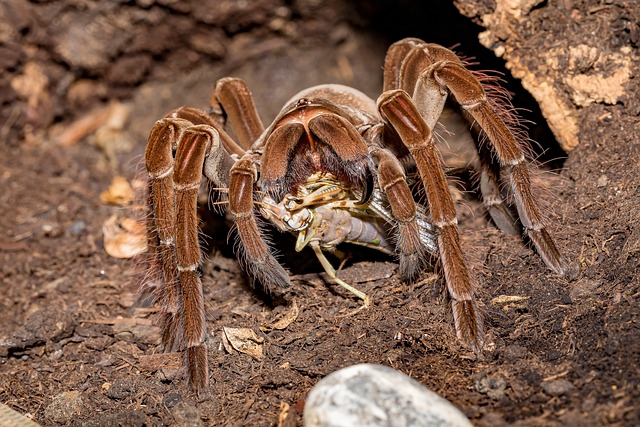Is your tarantula not touching its dinner? It’s a common puzzle for owners of these fuzzy friends. Fret not, this guide is brimming with insights to decode the fast and get your pet munching again.
Understanding the Eating Habits of a Tarantula
Tarantulas have unique eating habits that can surprise even the most experienced spider owners. These fascinating creatures might go weeks without touching their food, which is perfectly normal for them.
Before they shed their old skin in what’s called a molt, they often stop eating. This pre-molt fasting helps them get ready to grow.
A tarantula knows when to eat and how much it needs. Their meals vary in size and sometimes, a big, fatty prey can put them off food for a bit longer than usual. They also eat only live prey that moves around because it triggers their hunting instincts.
If the prey is too big or too small, your tarantula might not be interested at all. Remembering these habits helps you understand why your pet might be refusing to eat.
Common Reasons Why Tarantulas Stop Eating
Let’s take a peek into the spider-world reasons—a range from simple lifestyle changes, like molting to more concerning flags like health issues or environmental misfits—that could have your fuzzy friend turning away from its dinner plate..
Molting Process
Tarantulas shed their old skin in a process we call molting. Think of it as them trying on new clothes that fit better! Before they start this change, they often stop eating to prepare.
Their bodies need all their strength and energy to make a new shell for themselves.
Molts can be a tricky time for your tarantula. If there’s uneaten food around, it could hurt them while they’re vulnerable. They can’t move well and are super sensitive when shedding their skin.
So, keep prey size small and feeding frequency low before a molt to help out your eight-legged friend!
Cold Environment
Just like you might not feel like eating a cold sandwich on a winter day, tarantulas also lose their appetite in chilly conditions. They need warmth to digest their food properly. If it’s too cool where your spider friend lives, they will eat less or stop entirely to save energy.
Even indoors, if the room is too cold, this can make them want to skip meals.
You should keep your tarantula’s home warm enough but not too hot. Check the temperature and see if it’s right for their needs. You might want to get a small heater or move their tank to a warmer spot in your house so they feel cozy again – just be sure not to overheat them! Once it’s warm enough, you’ll likely see them start munching once more as if nothing happened.
Inappropriate Size of Prey
Sometimes, your tarantula may not eat because the food is just too big. Think of it like this—if a snack was as big as you are, would you want to tackle that? Probably not. And it’s the same for your tarantula.
If their belly looks swollen and hard, they might struggle with large meals even more.
So what can you do? Easy—offer them something smaller. A tinier meal won’t scare them off and is much easier to handle. This way, your tarantula can chow down without feeling overwhelmed or uncomfortable.
Plus, watching them go after prey that’s just the right size can be pretty fascinating!
Illness
Your tarantula might not be eating because it’s sick. Just like us, when tarantulas feel bad, they often don’t want food. One sign of a sick spider is a shrunken abdomen; this can mean your pet is dehydrated.
Look out for other hints that something’s wrong—if the spider seems weak or has trouble moving around, illness could be the cause.
Make sure you check your tarantula’s home to keep it healthy. A clean tank and fresh water are key. If things look serious, though, you may need help from an expert who knows about spiders.
Banishing sickness can get your tarantula on track and ready for more crickets or mealworms!
Stress
If your tarantula is not eating, it might be feeling stress. Changes in their world can scare them. This includes moves to new places or different weather patterns. They react by not eating because they want to stay safe and hidden.
A stressed tarantula behaves differently. It may curl up, covering its body with its legs and remaining motionless.. To feel better, it needs a calm place that feels like home. Make sure its space is just right with proper heat and dampness.
If the place feels good, the tarantula will relax and start eating again soon. Keep an eye out for signs of stress easing as your pet gets used to its surroundings after you’ve made them comfortable.
Solutions and Steps to Encourage Eating
Your tarantula not eating can be worrisome. Here are steps to help it get back to munching on its prey.
- Check the temperature in your pet’s home. It should be warm enough for your tarantula, as cold can make it eat less.
- Look at the size of the food you’re giving. If it’s too big or small, your spider might not want it. Find prey that’s just right.
- Create a cozy space with hiding spots in the enclosure. This can make your tarantula feel safe and more likely to eat.
- Make sure the enclosure is clean because a dirty home can lead to the development of parasites.
- Give them time if they’re getting ready to molt, known as premoult. They won’t eat during this time but will start again after they shed their old skin.
- Try different types of food because variety is key. Maybe your tarantula wants something new on its menu.
- Watch for signs of sickness—like a lack of movement or changes in color—and see a vet if needed.
Conclusion
If a tarantula isn’t eating, don’t worry too much at first. Check things like the cage setup and make sure it’s not just molting. Try giving it its favorite food again or add a hiding spot to help it feel safe.
Still no luck? It might be time to talk with a vet who knows about spiders. Remember, every pet is unique – so keep an eye on your pet!
FAQs
1. How long can tarantulas go without eating?
An adult tarantula, when provided with constant access to water, can endure without food for up to a year.
2. Should I worry if my tarantula stops eating suddenly?
It can be troubling, sure… but don’t panic just yet. Tarantulas often take breaks from eating and that’s okay. Watch your pet – if they seem stressed or look unwell, then it’s vet time.
3. How do you rehydrate a tarantula?
You can increase humidity by spraying the terrarium walls and substrate several times a day; this allows your spider to drink the remaining droplets. It’s also advisable to add a water dish permanently.
4. Is there anything special I should do to help my pet start eating again?
Keep things calm and cozy for them – clean water, a comfy hideout, and no vibrations around them. Give some space too; sometimes all they need is a little time to get back into munch-mode.







